Organizational Learning, Training, and Development Report Analysis
VerifiedAdded on 2023/04/05
|6
|1261
|471
Report
AI Summary
This report examines two cases related to customer service training and development within an organizational context. The first case analyzes a retail clothing store's customer service training program, evaluating the use of lecture, discussions, and simulation instructional methods. It suggests incorporating additional methods like behavior modeling, games, action learning, case studies, and role play to enhance training effectiveness and employee engagement. The second case focuses on job instruction training for a new employee in an automation setting, discussing the benefits of job instruction, coaching, and mentoring. The report highlights the importance of selecting appropriate training methods to improve employee performance, customer satisfaction, and overall organizational profitability. The assignment provides an overview of different training methods, their advantages and disadvantages, and how they can be applied to improve customer service and employee skills.
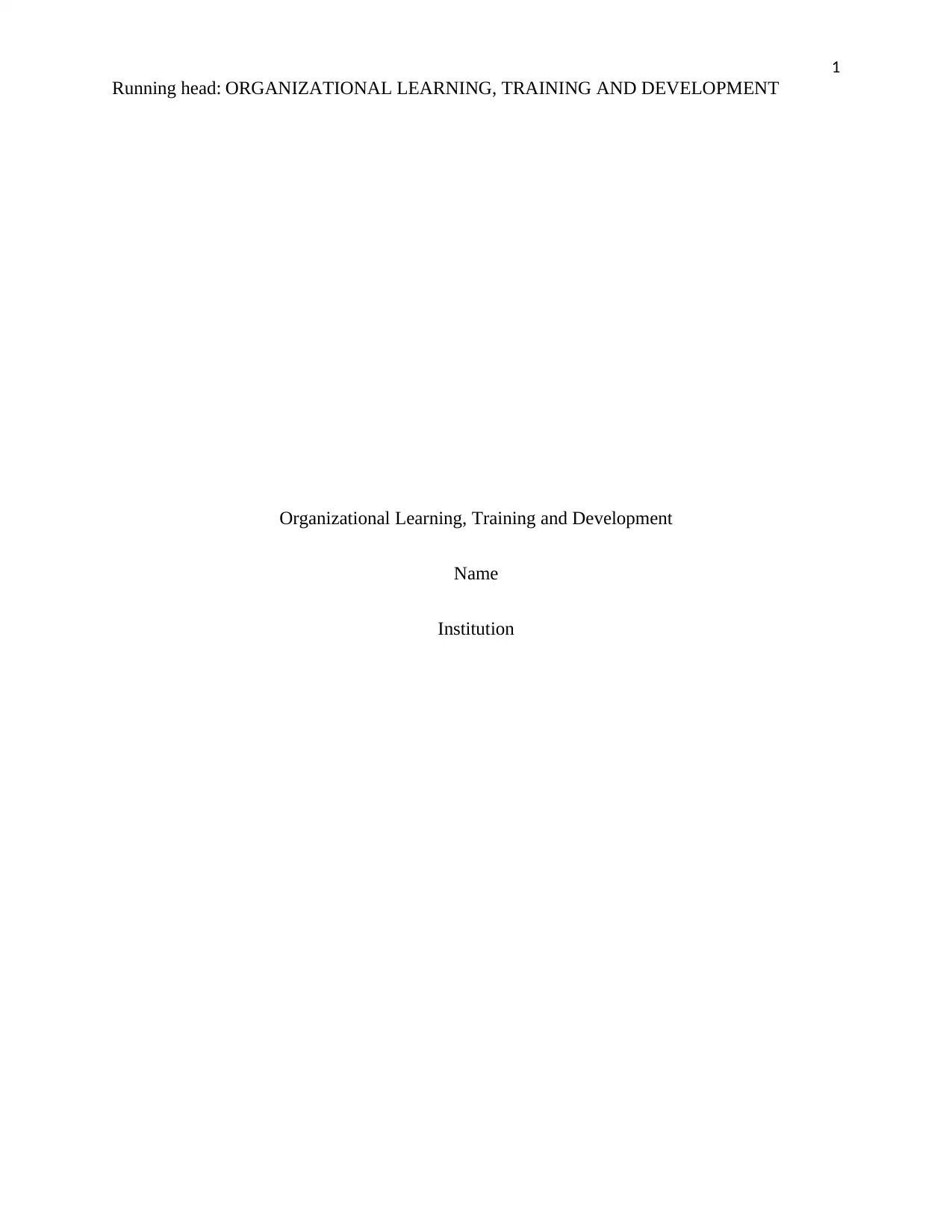
1
Running head: ORGANIZATIONAL LEARNING, TRAINING AND DEVELOPMENT
Organizational Learning, Training and Development
Name
Institution
Running head: ORGANIZATIONAL LEARNING, TRAINING AND DEVELOPMENT
Organizational Learning, Training and Development
Name
Institution
Paraphrase This Document
Need a fresh take? Get an instant paraphrase of this document with our AI Paraphraser
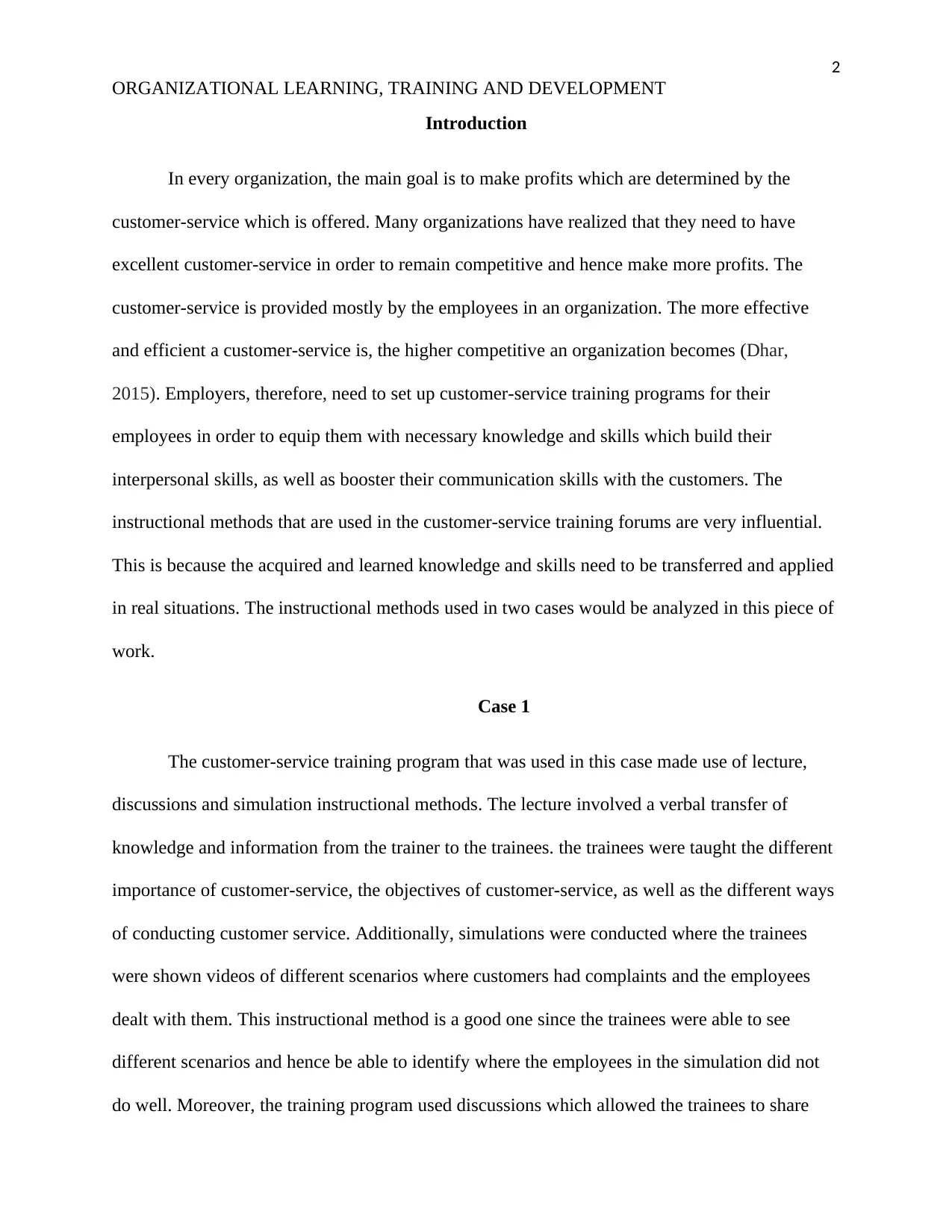
2
ORGANIZATIONAL LEARNING, TRAINING AND DEVELOPMENT
Introduction
In every organization, the main goal is to make profits which are determined by the
customer-service which is offered. Many organizations have realized that they need to have
excellent customer-service in order to remain competitive and hence make more profits. The
customer-service is provided mostly by the employees in an organization. The more effective
and efficient a customer-service is, the higher competitive an organization becomes (Dhar,
2015). Employers, therefore, need to set up customer-service training programs for their
employees in order to equip them with necessary knowledge and skills which build their
interpersonal skills, as well as booster their communication skills with the customers. The
instructional methods that are used in the customer-service training forums are very influential.
This is because the acquired and learned knowledge and skills need to be transferred and applied
in real situations. The instructional methods used in two cases would be analyzed in this piece of
work.
Case 1
The customer-service training program that was used in this case made use of lecture,
discussions and simulation instructional methods. The lecture involved a verbal transfer of
knowledge and information from the trainer to the trainees. the trainees were taught the different
importance of customer-service, the objectives of customer-service, as well as the different ways
of conducting customer service. Additionally, simulations were conducted where the trainees
were shown videos of different scenarios where customers had complaints and the employees
dealt with them. This instructional method is a good one since the trainees were able to see
different scenarios and hence be able to identify where the employees in the simulation did not
do well. Moreover, the training program used discussions which allowed the trainees to share
ORGANIZATIONAL LEARNING, TRAINING AND DEVELOPMENT
Introduction
In every organization, the main goal is to make profits which are determined by the
customer-service which is offered. Many organizations have realized that they need to have
excellent customer-service in order to remain competitive and hence make more profits. The
customer-service is provided mostly by the employees in an organization. The more effective
and efficient a customer-service is, the higher competitive an organization becomes (Dhar,
2015). Employers, therefore, need to set up customer-service training programs for their
employees in order to equip them with necessary knowledge and skills which build their
interpersonal skills, as well as booster their communication skills with the customers. The
instructional methods that are used in the customer-service training forums are very influential.
This is because the acquired and learned knowledge and skills need to be transferred and applied
in real situations. The instructional methods used in two cases would be analyzed in this piece of
work.
Case 1
The customer-service training program that was used in this case made use of lecture,
discussions and simulation instructional methods. The lecture involved a verbal transfer of
knowledge and information from the trainer to the trainees. the trainees were taught the different
importance of customer-service, the objectives of customer-service, as well as the different ways
of conducting customer service. Additionally, simulations were conducted where the trainees
were shown videos of different scenarios where customers had complaints and the employees
dealt with them. This instructional method is a good one since the trainees were able to see
different scenarios and hence be able to identify where the employees in the simulation did not
do well. Moreover, the training program used discussions which allowed the trainees to share
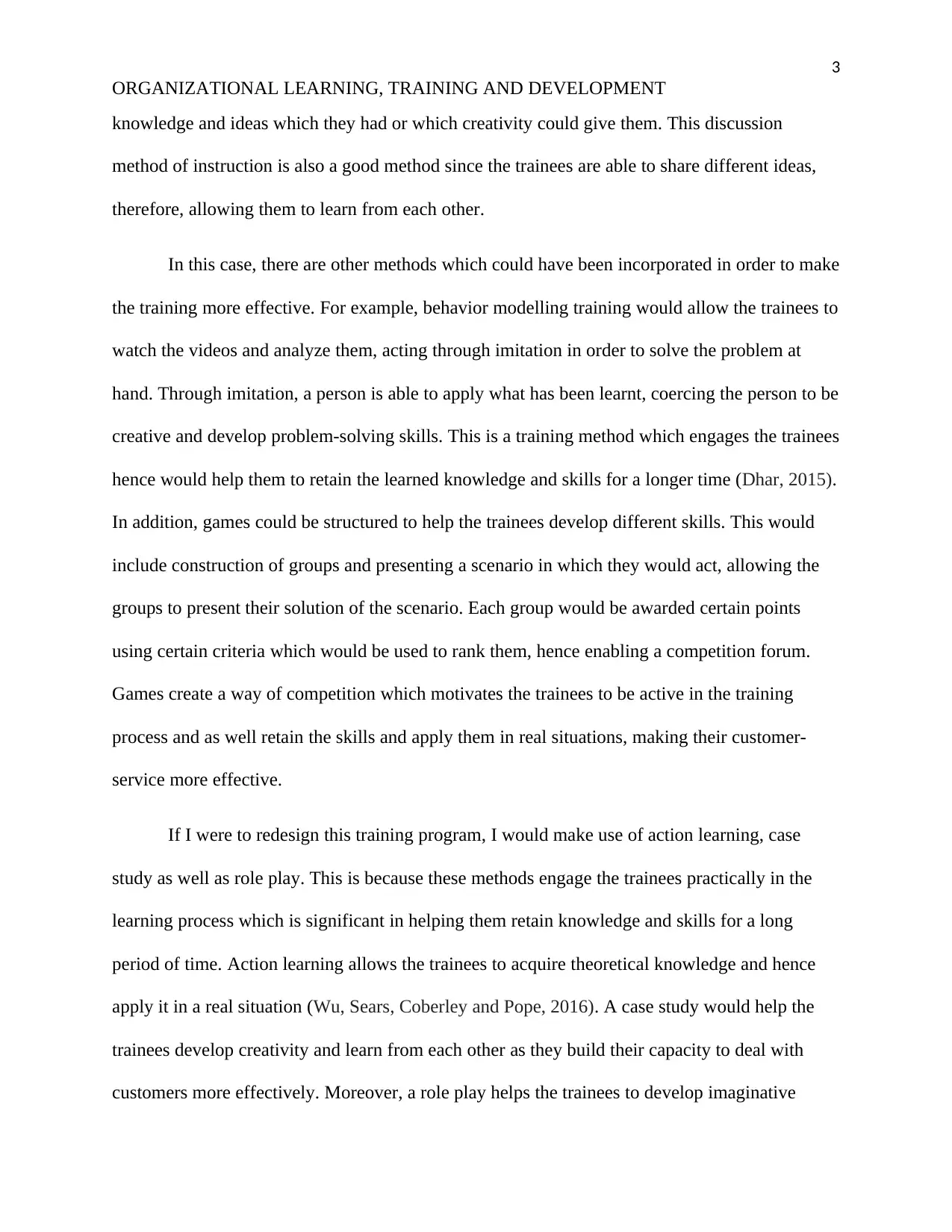
3
ORGANIZATIONAL LEARNING, TRAINING AND DEVELOPMENT
knowledge and ideas which they had or which creativity could give them. This discussion
method of instruction is also a good method since the trainees are able to share different ideas,
therefore, allowing them to learn from each other.
In this case, there are other methods which could have been incorporated in order to make
the training more effective. For example, behavior modelling training would allow the trainees to
watch the videos and analyze them, acting through imitation in order to solve the problem at
hand. Through imitation, a person is able to apply what has been learnt, coercing the person to be
creative and develop problem-solving skills. This is a training method which engages the trainees
hence would help them to retain the learned knowledge and skills for a longer time (Dhar, 2015).
In addition, games could be structured to help the trainees develop different skills. This would
include construction of groups and presenting a scenario in which they would act, allowing the
groups to present their solution of the scenario. Each group would be awarded certain points
using certain criteria which would be used to rank them, hence enabling a competition forum.
Games create a way of competition which motivates the trainees to be active in the training
process and as well retain the skills and apply them in real situations, making their customer-
service more effective.
If I were to redesign this training program, I would make use of action learning, case
study as well as role play. This is because these methods engage the trainees practically in the
learning process which is significant in helping them retain knowledge and skills for a long
period of time. Action learning allows the trainees to acquire theoretical knowledge and hence
apply it in a real situation (Wu, Sears, Coberley and Pope, 2016). A case study would help the
trainees develop creativity and learn from each other as they build their capacity to deal with
customers more effectively. Moreover, a role play helps the trainees to develop imaginative
ORGANIZATIONAL LEARNING, TRAINING AND DEVELOPMENT
knowledge and ideas which they had or which creativity could give them. This discussion
method of instruction is also a good method since the trainees are able to share different ideas,
therefore, allowing them to learn from each other.
In this case, there are other methods which could have been incorporated in order to make
the training more effective. For example, behavior modelling training would allow the trainees to
watch the videos and analyze them, acting through imitation in order to solve the problem at
hand. Through imitation, a person is able to apply what has been learnt, coercing the person to be
creative and develop problem-solving skills. This is a training method which engages the trainees
hence would help them to retain the learned knowledge and skills for a longer time (Dhar, 2015).
In addition, games could be structured to help the trainees develop different skills. This would
include construction of groups and presenting a scenario in which they would act, allowing the
groups to present their solution of the scenario. Each group would be awarded certain points
using certain criteria which would be used to rank them, hence enabling a competition forum.
Games create a way of competition which motivates the trainees to be active in the training
process and as well retain the skills and apply them in real situations, making their customer-
service more effective.
If I were to redesign this training program, I would make use of action learning, case
study as well as role play. This is because these methods engage the trainees practically in the
learning process which is significant in helping them retain knowledge and skills for a long
period of time. Action learning allows the trainees to acquire theoretical knowledge and hence
apply it in a real situation (Wu, Sears, Coberley and Pope, 2016). A case study would help the
trainees develop creativity and learn from each other as they build their capacity to deal with
customers more effectively. Moreover, a role play helps the trainees to develop imaginative
⊘ This is a preview!⊘
Do you want full access?
Subscribe today to unlock all pages.

Trusted by 1+ million students worldwide
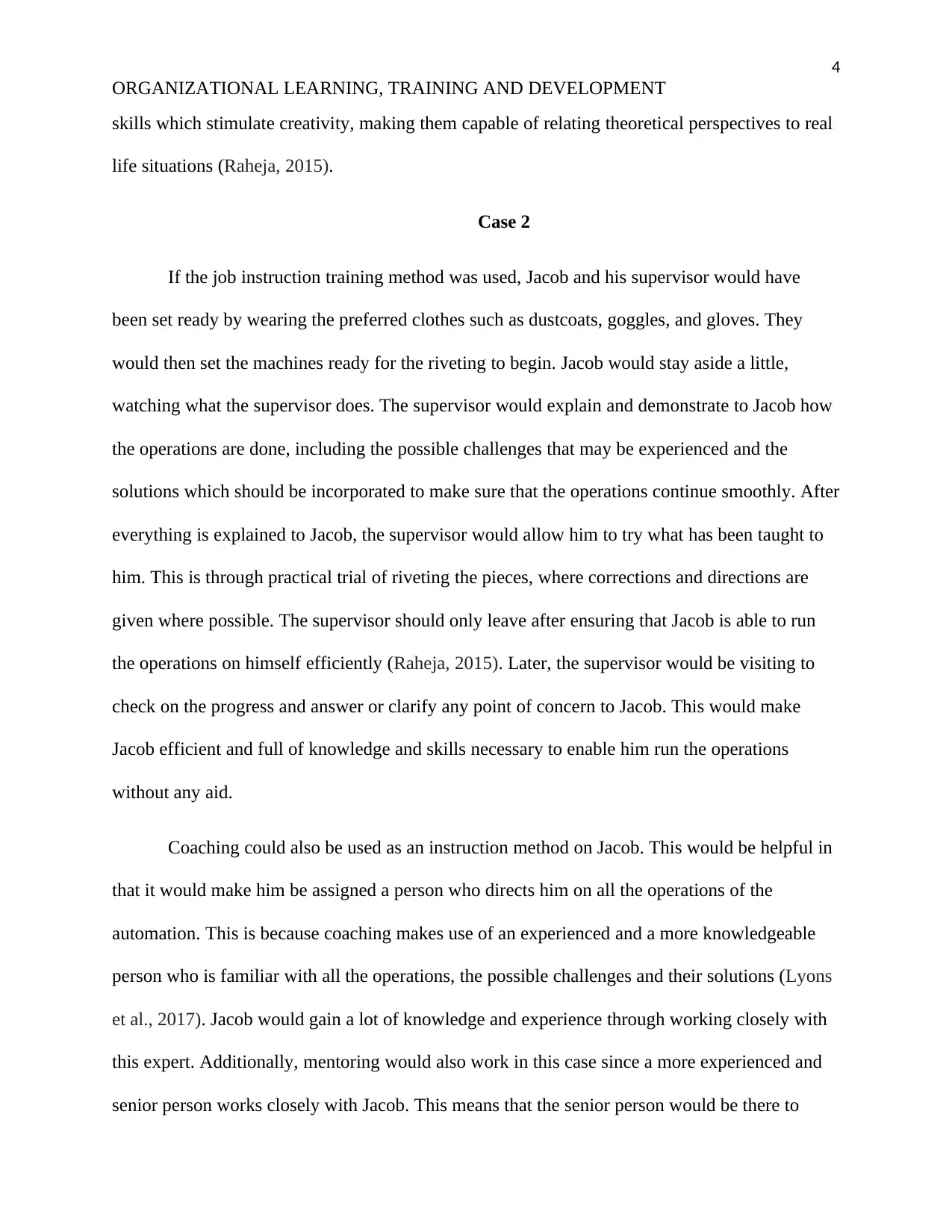
4
ORGANIZATIONAL LEARNING, TRAINING AND DEVELOPMENT
skills which stimulate creativity, making them capable of relating theoretical perspectives to real
life situations (Raheja, 2015).
Case 2
If the job instruction training method was used, Jacob and his supervisor would have
been set ready by wearing the preferred clothes such as dustcoats, goggles, and gloves. They
would then set the machines ready for the riveting to begin. Jacob would stay aside a little,
watching what the supervisor does. The supervisor would explain and demonstrate to Jacob how
the operations are done, including the possible challenges that may be experienced and the
solutions which should be incorporated to make sure that the operations continue smoothly. After
everything is explained to Jacob, the supervisor would allow him to try what has been taught to
him. This is through practical trial of riveting the pieces, where corrections and directions are
given where possible. The supervisor should only leave after ensuring that Jacob is able to run
the operations on himself efficiently (Raheja, 2015). Later, the supervisor would be visiting to
check on the progress and answer or clarify any point of concern to Jacob. This would make
Jacob efficient and full of knowledge and skills necessary to enable him run the operations
without any aid.
Coaching could also be used as an instruction method on Jacob. This would be helpful in
that it would make him be assigned a person who directs him on all the operations of the
automation. This is because coaching makes use of an experienced and a more knowledgeable
person who is familiar with all the operations, the possible challenges and their solutions (Lyons
et al., 2017). Jacob would gain a lot of knowledge and experience through working closely with
this expert. Additionally, mentoring would also work in this case since a more experienced and
senior person works closely with Jacob. This means that the senior person would be there to
ORGANIZATIONAL LEARNING, TRAINING AND DEVELOPMENT
skills which stimulate creativity, making them capable of relating theoretical perspectives to real
life situations (Raheja, 2015).
Case 2
If the job instruction training method was used, Jacob and his supervisor would have
been set ready by wearing the preferred clothes such as dustcoats, goggles, and gloves. They
would then set the machines ready for the riveting to begin. Jacob would stay aside a little,
watching what the supervisor does. The supervisor would explain and demonstrate to Jacob how
the operations are done, including the possible challenges that may be experienced and the
solutions which should be incorporated to make sure that the operations continue smoothly. After
everything is explained to Jacob, the supervisor would allow him to try what has been taught to
him. This is through practical trial of riveting the pieces, where corrections and directions are
given where possible. The supervisor should only leave after ensuring that Jacob is able to run
the operations on himself efficiently (Raheja, 2015). Later, the supervisor would be visiting to
check on the progress and answer or clarify any point of concern to Jacob. This would make
Jacob efficient and full of knowledge and skills necessary to enable him run the operations
without any aid.
Coaching could also be used as an instruction method on Jacob. This would be helpful in
that it would make him be assigned a person who directs him on all the operations of the
automation. This is because coaching makes use of an experienced and a more knowledgeable
person who is familiar with all the operations, the possible challenges and their solutions (Lyons
et al., 2017). Jacob would gain a lot of knowledge and experience through working closely with
this expert. Additionally, mentoring would also work in this case since a more experienced and
senior person works closely with Jacob. This means that the senior person would be there to
Paraphrase This Document
Need a fresh take? Get an instant paraphrase of this document with our AI Paraphraser
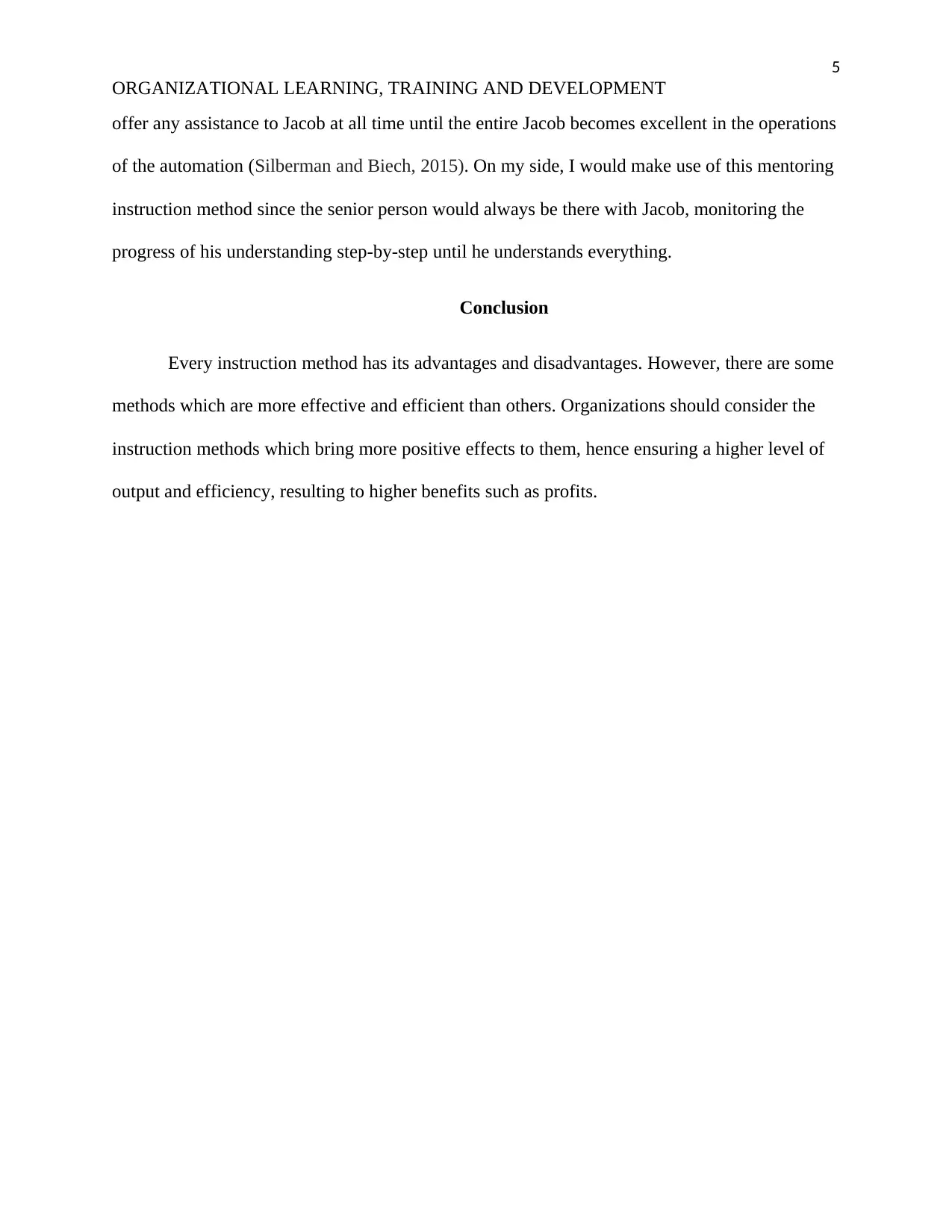
5
ORGANIZATIONAL LEARNING, TRAINING AND DEVELOPMENT
offer any assistance to Jacob at all time until the entire Jacob becomes excellent in the operations
of the automation (Silberman and Biech, 2015). On my side, I would make use of this mentoring
instruction method since the senior person would always be there with Jacob, monitoring the
progress of his understanding step-by-step until he understands everything.
Conclusion
Every instruction method has its advantages and disadvantages. However, there are some
methods which are more effective and efficient than others. Organizations should consider the
instruction methods which bring more positive effects to them, hence ensuring a higher level of
output and efficiency, resulting to higher benefits such as profits.
ORGANIZATIONAL LEARNING, TRAINING AND DEVELOPMENT
offer any assistance to Jacob at all time until the entire Jacob becomes excellent in the operations
of the automation (Silberman and Biech, 2015). On my side, I would make use of this mentoring
instruction method since the senior person would always be there with Jacob, monitoring the
progress of his understanding step-by-step until he understands everything.
Conclusion
Every instruction method has its advantages and disadvantages. However, there are some
methods which are more effective and efficient than others. Organizations should consider the
instruction methods which bring more positive effects to them, hence ensuring a higher level of
output and efficiency, resulting to higher benefits such as profits.
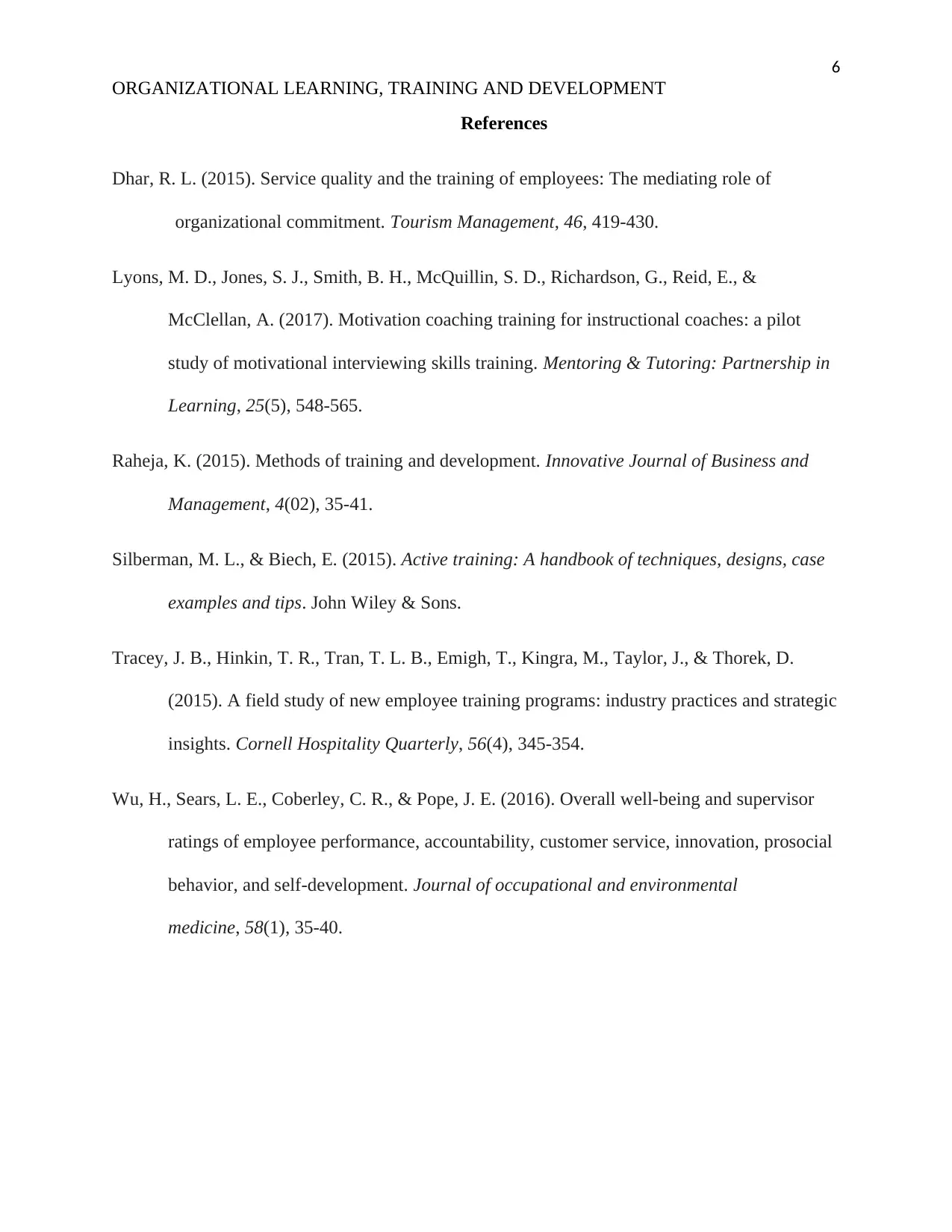
6
ORGANIZATIONAL LEARNING, TRAINING AND DEVELOPMENT
References
Dhar, R. L. (2015). Service quality and the training of employees: The mediating role of
organizational commitment. Tourism Management, 46, 419-430.
Lyons, M. D., Jones, S. J., Smith, B. H., McQuillin, S. D., Richardson, G., Reid, E., &
McClellan, A. (2017). Motivation coaching training for instructional coaches: a pilot
study of motivational interviewing skills training. Mentoring & Tutoring: Partnership in
Learning, 25(5), 548-565.
Raheja, K. (2015). Methods of training and development. Innovative Journal of Business and
Management, 4(02), 35-41.
Silberman, M. L., & Biech, E. (2015). Active training: A handbook of techniques, designs, case
examples and tips. John Wiley & Sons.
Tracey, J. B., Hinkin, T. R., Tran, T. L. B., Emigh, T., Kingra, M., Taylor, J., & Thorek, D.
(2015). A field study of new employee training programs: industry practices and strategic
insights. Cornell Hospitality Quarterly, 56(4), 345-354.
Wu, H., Sears, L. E., Coberley, C. R., & Pope, J. E. (2016). Overall well-being and supervisor
ratings of employee performance, accountability, customer service, innovation, prosocial
behavior, and self-development. Journal of occupational and environmental
medicine, 58(1), 35-40.
ORGANIZATIONAL LEARNING, TRAINING AND DEVELOPMENT
References
Dhar, R. L. (2015). Service quality and the training of employees: The mediating role of
organizational commitment. Tourism Management, 46, 419-430.
Lyons, M. D., Jones, S. J., Smith, B. H., McQuillin, S. D., Richardson, G., Reid, E., &
McClellan, A. (2017). Motivation coaching training for instructional coaches: a pilot
study of motivational interviewing skills training. Mentoring & Tutoring: Partnership in
Learning, 25(5), 548-565.
Raheja, K. (2015). Methods of training and development. Innovative Journal of Business and
Management, 4(02), 35-41.
Silberman, M. L., & Biech, E. (2015). Active training: A handbook of techniques, designs, case
examples and tips. John Wiley & Sons.
Tracey, J. B., Hinkin, T. R., Tran, T. L. B., Emigh, T., Kingra, M., Taylor, J., & Thorek, D.
(2015). A field study of new employee training programs: industry practices and strategic
insights. Cornell Hospitality Quarterly, 56(4), 345-354.
Wu, H., Sears, L. E., Coberley, C. R., & Pope, J. E. (2016). Overall well-being and supervisor
ratings of employee performance, accountability, customer service, innovation, prosocial
behavior, and self-development. Journal of occupational and environmental
medicine, 58(1), 35-40.
⊘ This is a preview!⊘
Do you want full access?
Subscribe today to unlock all pages.

Trusted by 1+ million students worldwide
1 out of 6
Related Documents
Your All-in-One AI-Powered Toolkit for Academic Success.
+13062052269
info@desklib.com
Available 24*7 on WhatsApp / Email
![[object Object]](/_next/static/media/star-bottom.7253800d.svg)
Unlock your academic potential
Copyright © 2020–2025 A2Z Services. All Rights Reserved. Developed and managed by ZUCOL.





